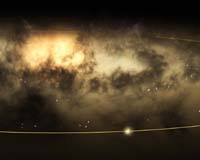| . |  |
. |
Manoa HI (SPX) Jul 06, 2009 Two University of Hawaii at Manoa astronomers have found a binary star-disk system in which each star is surrounded by the kind of dust disk that is frequently the precursor of a planetary system. Doctoral student Rita Mann and Dr. Jonathan Williams used the Submillimeter Array on Mauna Kea, Hawaii to make the observations. A binary star system consists of two stars bound together by gravity that orbit a common center of gravity. Most stars form as binaries, and if both stars are hospitable to planet formation, it increases the likelihood that scientists will discover Earth-like planets. This binary system, 253-1536, stands out as the first known example of two optically visible stars, each surrounded by a disk with enough mass to form a planetary system like our own. It lies 1,300 light-years from Earth, in the famous Orion Nebula, the kind of rich cluster of stars that is a common birth environment for most stars in our Milky Way galaxy, including our sun. One of the disks was discovered in an image taken with the Hubble Space Telescope, but the other disk was hidden in the glare of the star. Hubble saw only the disk shadow, so the amount of material and its capability for planet formation was unknown until the UH team made the SMA observations. "The SMA was able to image the binary system at almost the same level of detail as the Hubble Space Telescope, but in the extreme infrared, where we can see the glow from the dust, rather than its shadow," explained Mann. The two stars are 400 times farther from each other than Earth is from the sun. They would take 4,500 years, or about the length of human recorded history, to complete one orbit around their common center. Both stars are only about a third the mass of our sun and are much cooler and redder in color. Viewed from a potential future planet, the stellar neighbor would appear as an intense point in the night sky, about one thousand times brighter than the brightest star in our night sky, Sirius. Planets around the other star would be visible only through telescopes, but they would be within reach of spacecraft from a civilization with the same level of technology as ours. The larger disk in 253-1536 is also the most massive found in the Orion Nebula so far. The discovery of this massive disk and the binary disk system improve our understanding of how common planet formation is in our Galaxy and place our Solar System in context. Share This Article With Planet Earth
Related Links University of Hawaii at Manoa Stellar Chemistry, The Universe And All Within It
 Intense Heat Killed The Universe's Would-Be Galaxies
Intense Heat Killed The Universe's Would-Be GalaxiesDurham, UK (SPX) Jul 02, 2009 Our Milky Way galaxy only survived because it was already immersed in a large clump of dark matter which trapped gases inside it, scientists led by Durham University's Institute for Computational Cosmology (ICC) found. The research, to be presented at an international conference, also forms a core part of a new ICC movie charting the evolution of the Milky Way to be shown at the Royal ... read more |
|
| The content herein, unless otherwise known to be public domain, are Copyright 1995-2009 - SpaceDaily. AFP and UPI Wire Stories are copyright Agence France-Presse and United Press International. ESA Portal Reports are copyright European Space Agency. All NASA sourced material is public domain. Additional copyrights may apply in whole or part to other bona fide parties. Advertising does not imply endorsement,agreement or approval of any opinions, statements or information provided by SpaceDaily on any Web page published or hosted by SpaceDaily. Privacy Statement |